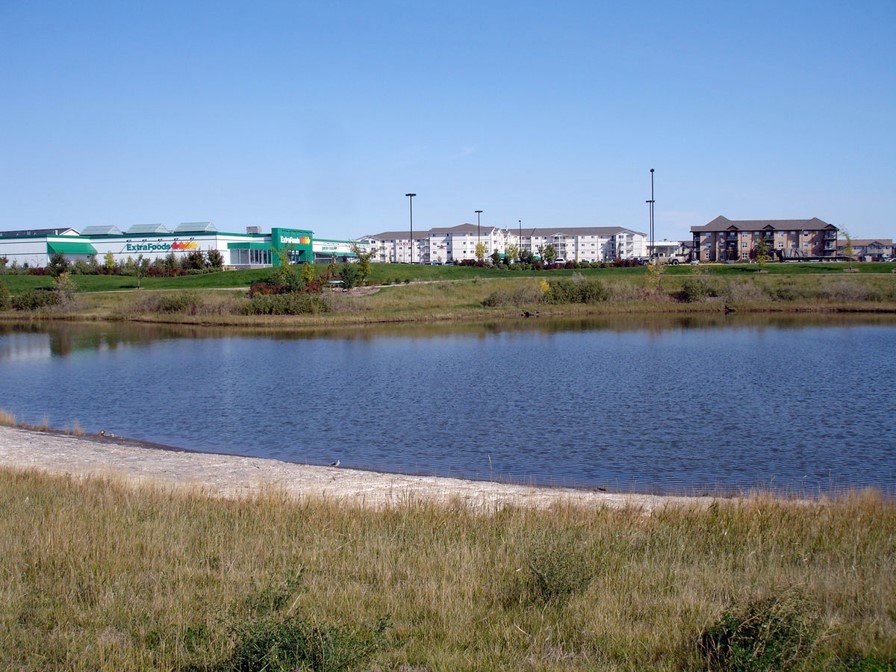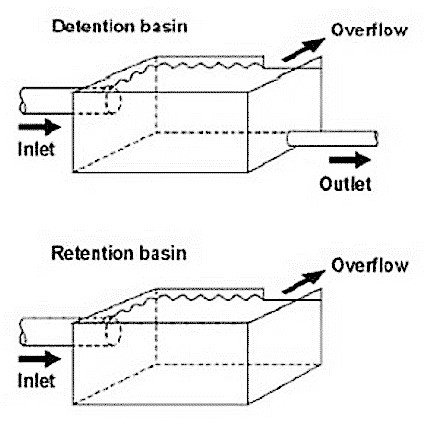Executive Summary
Retention basins are among the most frequently implemented storm water management systems. They are used to collect surface runoff and to improve the quality of water by natural processes such as sedimentation, decomposition, solar disinfection and soil filtration. In comparison to dry ponds (which hold runoff for a limited period of time and then release the stored water at once), retention basins constantly keep standing water, allowing the development of a new habitat. This also allows settled particles to be treated biologically (GDSDS 2005). Water from retention ponds can then be reused for groundwater recharge, irrigation or any other purpose, optionally requiring further treatment. As a natural system, retention basins do not need energy or high-tech appliances. Primary implementation costs of retention basins are high and constant maintenance is inevitable, as otherwise pollutant export and erosion can occur (UNHSC 2010).
| In | Out |
|---|---|
Freshwater, Treated Water |
Introduction
Today, retention basins are one of the most commonly used stormwater treatment systems (see also stormwater management). Basically, they are ponds to store rainwater and further filter it from sediment by mimicking natural undeveloped watershed conditions (MEM 2002).
By storing water in the basin, retention ponds help to impede the negative effects of excess storm water, preventing successional flooding, and can further be used to recharge groundwater (see also surface groundwater recharge or subsurface groundwater recharge). Also, water quality increases immensely, because the standing water is filtered from solid and soluble pollutants as well as excess nutrients (see also pathogens and contaminants and sedimentation) (GDSDS 2005; MEM 2002). If not reused for groundwater recharge, it may be reused in agriculture (e.g. irrigation, fertigation or aquaculture), industry or at household level after an appropriate secondary treatment if required (e.g. free surface, vertical flow constructed wetlands or non planted filter).
Basic Design Principles
Adapted from GDSDS (2005) & EPA (1999)

The design of a retention basin needs to be well fitted to its surroundings. When choosing a suitable site, the main factors to consider are the cost effectiveness of the area as well as its ability to support the pond environment.
Also, retention basins are best built where stormwater naturally flows and collects (MEM 2002). Enough space should be available, as the ponds require a minimum contributing area of five hectares. A small pool (called sediment forebay) of about 10 percent of the main pond’s size can further help to pre-treat incoming water by keeping back rough particles. The size of a retention basin is dependent on several factors such as topography, the effective contributing area, and the relationship between the amounts of incoming and discharged water.
Planting native aquatic vegetation further helps to improve the function of retention basins. Nutrients are removed more effectively because of the photosynthetic activities and bacteria attached to the plants (see also the nutrient cycle).
As retention ponds need to hold back a constant level of water, highly permeable soils can be a drawback. If this is the case, clay blankets may be used to overlay or compact the existing soil and therefore make it less absorptive.
Retention vs. Detention Basins
Retention basins are not to be confused with detention basins. Whereas retention basins hold back a constant amount of water (and are therefore also called 'wet detention ponds'), detention basins are only used for temporary storage of rainwater. To release water from the basin, an additional outlet needs to be constructed to the ground of detention ponds (TUHH n.y.).

Cost Considerations
Even though high investments are needed for the construction of retention basins, the overall marginal costs are low, because retention basins are long-lived, usually lasting for over 20 years. Once in operation, only minimal maintenance costs arise.
The United States Environmental Protection Agency (EPA) states that between $17.50 and $35 USD need to be invested per cubic metre. Further spending includes permits, design and construction, as well as maintenance (EPA 1999).
Due to higher costs of land, it is usually more expensive to retrofit retention basins to already developed areas compared to constructing one in an undeveloped region.
Health Aspects
Adapted from UNHSC (2010)
Different concerns arise related to human and ecosystem health: For one part, standing water may be a drowning hazard. Further, ponds are a beneficial ecosystem for mosquitoes, which can also be related to increased transmittance of diseases.
Moreover, in water scarce areas or where agriculture is practised, inhabitants may reuse the water from the ponds directly without monitoring the water quality.
Furthermore, eutrophication can occur if excess nutrients are held back in the basin. Also, if the weather is exceptionally warm, the water can heat up exceedingly, impacting downstream aquatic habitats. If this is the case, gravel subdrains can help to cool down the water outlet.
Operation and Maintenance
Adapted from UNHSC (2010) & GDSDS (2005)
Even though only minimal maintenance is needed, it is unavoidable in order to prevent erosion and suspension of sediment, which could lead to unwanted sediment export. Required routine work includes quarterly inspections of inlets and outlets as well as sediment and trash dredging. Mowing around the margins is possible, but increases costs and further reduces possible habitat.
At a Glance
| Working Principle | Surface run-off is stored permanently in ponds, allowing increased storm water management and quality enhancement through natural processes. |
| Capacity/Adequacy | Retention basins require a large area of land and are only applicable to areas with high rainfall and enough free space. |
| Performance | Retention basins filter pollutants such as metals, nutrients, sediments, or organics by sedimentation. Further removal of pollutants is achieved through algal and wetland plant uptake as well as bacterial decomposition (EPA 1999) |
| Costs | High costs arise for the construction of retention basins and the value of the land. Once in operation, only minimal maintenance costs occur. |
| Self-help Compatibility | Construction requires expert design; operation, monitoring and maintenance require skilled staff. |
| O&M | Basins have to be cleared from excess sediment and trash. Also, quarterly inspections of water in- and outlets are needed. |
| Reliability | Reliability persistence of retention basins is very high if well maintained, with a life span of usually more than 20 years. |
| Main strength | Floodwater can be controlled and water quality is enhanced. |
| Main weakness | Large land areas need to be available to build ponds; risk of uncontrolled reuse and mosquito breading. |
One main prerequisite for the construction of retention basins is space. A minimum contributing area of five hectares is necessary for a successful implementation (GDSDS 2005).
Retention ponds are not suited for areas with low precipitation because the basins must be able to constantly hold water. This can also be hindered if the soil is highly permeable. It is then advisable to overlay the existing ground with clay blankets.
Detention and Retention Basins
Performance of Stormwater Retention Ponds and Constructed Wetlands in Reducing Microbial Concentrations
This report documents the efforts to evaluate simple predictive relationships affecting concentrations of indicator organisms in stormwater runoff based on environmental conditions. It describes the breadth of surface water resources affected by bacterial stressors and identifies the needs for continued research on understanding related engineering approaches. Combined in this report are bench- and pilot-scale data to assess first-order equations to better predict the performance of constructed wetland and retention pond best management practices (BMPs).
EPA (2006): Performance of Stormwater Retention Ponds and Constructed Wetlands in Reducing Microbial Concentrations. Washington, D.C.: United States Environmental Protection Agency (EPA) URL [Accessed: 04.09.2012] PDFWater Harvesting
Water harvesting has been practiced successfully for millennia in parts of the world – and some recent interventions have also had significant local impact. Yet water harvesting’s potential remains largely unknown, unacknowledged and unappreciated. These guidelines cover a wide span of technologies from large-scale floodwater spreading to practices that collect and store water from household compounds.
MEKDASCHI STUDER, R. LINIGER, H. (2013): Water Harvesting. Guidelines to Good Practice. Bern/Amsterdam/Wageningen/Rome: Centre for Development and Environment (CDE), Rainwater Harvesting Implementation Network (RAIN), MetaMeta, The International Fund for Agricultural Development (IFAD) URL [Accessed: 12.03.2019] PDFStudy of Retention/Treatment Basins in Highways. Case Study of A24 (Northern Portugal)
This case study looks at retention basins near highways. It explores the mitigating impact of retention basins on the water and soil pollution made by traffic, by analysing runoff water quality and the efficiency of five basins located in a highway in northern Portugal. The obtained results are then compared with previous case studies.
BENTES, I. MONTEIRO, M. DUARTE, A. PINTO, T. MATOS, A. MATOS, C. (2011): Study of Retention/Treatment Basins in Highways. Case Study of A24 (Northern Portugal). (= Proceedings of the XIVth IWRA World Water Congress, 2011 ). Pernambuco, Brazil: International Water Resources Association (IWRA) URL [Accessed: 05.09.2012] PDFLong-term Simulation of the Removal of Pollutants in Retention Basins. European Water Management Online
The paper describes a method for the long-term simulation of the discharge of pollutants to the environment from storm sewer overflows in combined sewer systems, which has a connected retention basin. The method includes both the influence of the flow-dependant sedimentation and the variation of the settling velocity of the particles. The results show that including these effects lead to significant lower discharges of pollutants compared to conventional methods of estimation.
LARSEN, T. NEERUP-JENSEN, O. KAASGAARD, M. (2005): Long-term Simulation of the Removal of Pollutants in Retention Basins. European Water Management Online. Hennef: European Water Association (EWA) URL [Accessed: 05.09.2012] PDFSustainable Stormwater Management. Use of Multifunctional Landscapes in Urban Drainage for Flood Control
This paper presents a case study of an urban flood control project using a stormwater retention pond, designed to allow multiple use of an urban space, under the concept of multifunctional landscapes. The study area is the city of Mesquita in Brazil.
REZENDE, O.M. CARNEIRO, P.R. MIGUEZ, M.G. (2011): Sustainable Stormwater Management. Use of Multifunctional Landscapes in Urban Drainage for Flood Control. (= Proceedings of the 12th International Conference on Urban Drainage, September 2011 ). Porto Alegre, Brazil: International Conference on Urban Drainage URL [Accessed: 05.09.2012] PDFDesign Manual: Retention Basin
Step-by-step manual for the design and construction of a retention basin, including helpful material such as a sample maintenance schedule and a cost worksheet.
SETTY, K. (n.y): Design Manual: Retention Basin. Santa Barbara, CA: School of Environmental Science and Management URL [Accessed: 04.09.2012] PDFStormwater Quantity and Quality Management (SQQM)
Webpage from the Iowa-Cedar Watershed Interagency Coordination Team, containing information on wet detention ponds. Information is also given to choose the most efficient construction.
Storm Water Center
This site by the Stormwater Manager's Resource Center (SMRC) is designed for stormwater practitioners, local government officials and people needing technical assistance. It contains information on stormwater management, including a factsheet about wet ponds.
The Use of Retention Ponds in Residential Settings
Looking at two retention ponds in South Alabama, USA, the difference between inflowing and outflowing water quality of retention ponds in residential areas is measured. Hereby, the focus is set on the turbidity and the pH concentration of the water.
Stormwater Retention Ponds: Maintenance vs. Efficiency
This case study was done in Minneapolis (USA). It compares maintenance frequency with cost efficiency of retention ponds, taking at hand data of several retention ponds of the region.
